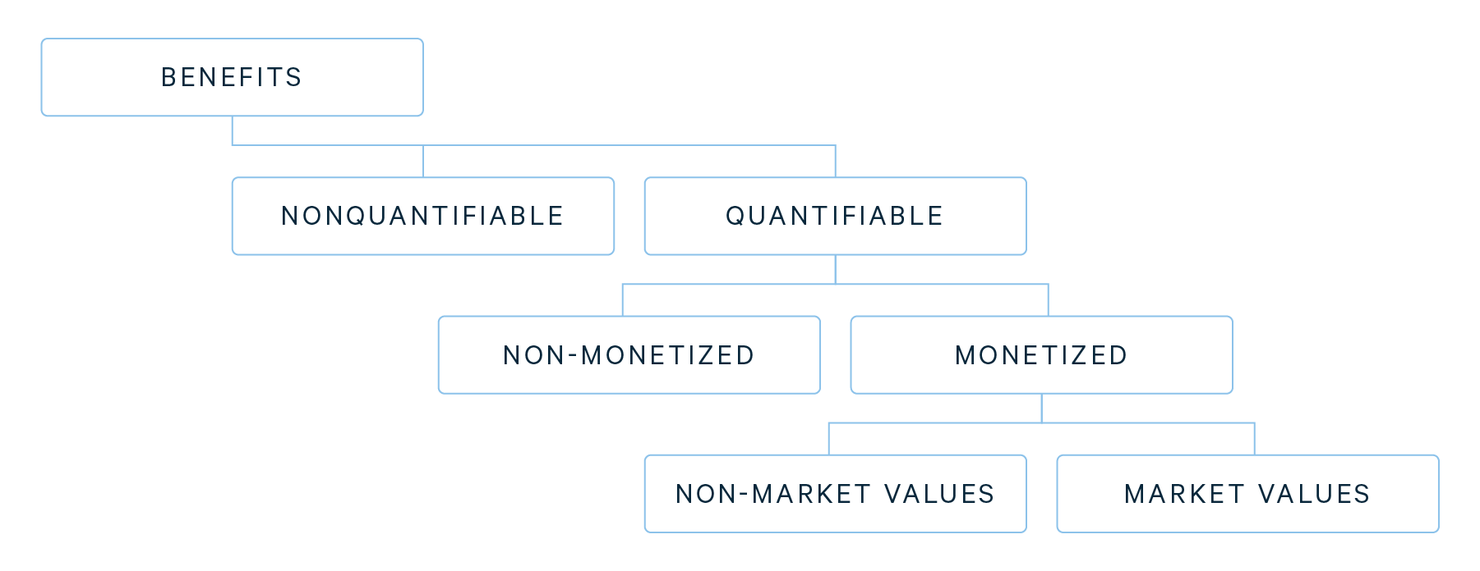Value of Science 103: Categorizing the Socioeconomic Benefits of Scientific Information, Part 1
This installment of the VALUABLES explainer series describes a three-step process for categorizing the societal benefits from Earth science information when we use it to inform decisions.
The information that scientific research generates is valuable to society—but where should scientists start if they want to measure that value? Upcoming explainers will introduce a three-step impact assessment framework that scientists can use to quantify the value of information. The framework is well-suited to measuring some kinds of benefits more than others, so a launching point is to begin thinking categorically about socioeconomic benefits. In particular, this explainer encourages scientists to categorize the socioeconomic benefits their information produces by answering three questions. First, when someone uses this information to make a decision, does it generate benefits that can be quantified? If quantifiable, can these benefits be monetized? If monetizable, do these benefits have market value? Categorizing benefits according to these three tiers of questions can help scientists describe more precisely how the information they produce improves outcomes that matter for people and the environment.
Why Categorize Benefits?
As we learned in “Value of Science 101” and “Value of Science 102,” benefits are things of value that individuals, companies, or society as a whole receive as a result of implementing a project, program, or policy. When projects, programs, and policies generate new scientific information that helps people make better decisions, the value of that information is reflected in the improvements to outcomes that matter to people and the environment. These benefits can be tangible (such as increases in crop yield or cost savings for natural resource managers), or less tangible (such as improved recreational fishing experiences or a more pleasant walk along the beach thanks to cleaner water).
While describing benefits as tangible or intangible may be intuitive, economists take a different approach to classifying the benefits that arise when people use scientific information to make decisions. The three primary ways economists categorize benefits are by whether the benefits are quantifiable, whether the benefits should be monetized, and whether the benefits have market value. Figure 1 shows these three tiers of categorization and how they relate to one another, with the highest level of categorization being quantifiability.
Figure 1. A Scheme for Categorizing the Benefits of Scientific Information

Categorizing benefits in this way can provide an organizing framework for the scientific community to have discussions about the benefits of information, help communicate the breadth of benefit types that arise from Earth science, and help identify gaps in our understanding of these benefits.
Quantifiable vs. Nonquantifiable Benefits
Some socioeconomic benefits of scientific information are relatively easy to quantify. These quantifiable benefits are tied to outcomes with commonly used metrics. For example, increases in firm profits and decreases in human illness are quantifiable benefits. Nonquantifiable benefits, on the other hand, are tied to outcomes that do not have easily quantifiable metrics. To categorize the various benefits of a new piece of scientific information, a useful first step is to split the benefits into quantifiable and nonquantifiable benefits.
The kinds of metrics used to measure quantifiable benefits include bushels per acre of corn production, milligrams per liter of a pollutant, or hours of personnel time. When these metrics are applicable, measuring benefits requires researchers to assess the changes in magnitude of socioeconomic outcomes along these metrics. For example, a benefit can be quantified as an increase in the bushels per acre of corn produced on a farm, or a reduction in the milligrams per liter of a pollutant in a lake. The terms, concepts, and methods discussed in this explainer series will focus primarily on measuring quantifiable benefits.

A benefit might be nonquantifiable for the following three reasons:
- No quantitative evidence: Researchers may lack quantitative evidence on the degree to which actions taken in response to new information influence socioeconomic outcomes. For example, researchers may know that satellite information about wildfire smoke was used to issue air quality health advisories, but they may not have data on how many individuals complied with the advisories. This lack of compliance data would make it difficult to quantify the degree to which the advisories protected people from wildfire smoke exposure.
- No comparable metrics: Some types of benefits may be very difficult to quantify using metrics that are comparable across individuals. An example of this type of benefit is the spiritual value of wildlife to indigenous tribes. It would be difficult, if not impossible, to measure spiritual value in a way that is comparable across individuals within a tribe or across multiple tribes.
- Inaccessible decision context: Some benefits of scientific information are nonquantifiable because the decision context in which the information is used cannot be studied due to confidentiality, secrecy, or national security concerns. For example, satellite data are crucial for military activities, and these activities generate important national security benefits. However, it is unlikely that military information users will reveal how this information influences their decisionmaking. Likewise, scientific information can have important benefits to private-sector users, but how companies profit from the information is likely to be a trade secret. In both cases, the inability to understand the decision context makes the benefits of the information nonquantifiable.
Although it is impossible to produce quantitative estimates of nonquantifiable benefits, that doesn’t mean these benefits should be ignored. It may be possible to document how nonquantifiable benefits arise from decisions that use new scientific information, and describe qualitatively how the magnitude of these benefits may change (i.e., whether they are likely to increase or decrease) as a result of the new information.
Monetized and Non-monetized Benefits
Sometimes, it is sufficient to express quantifiable socioeconomic benefits in terms of a non-monetary metric, such as the number of lives saved or additional acres of forests conserved. However, as “Value of Science 101” describes, it is sometimes useful to express the magnitude of benefits in monetary terms, using currency units such as dollars or euros. The fact that quantifiable benefits can be expressed in monetary or non-monetary terms is illustrated in the second level of categorization in Figure 1.
Whether a benefit should be monetized or not depends primarily on how feasible it is to express the magnitude of the benefit in monetary terms and how useful a monetized value is. In some cases, demonstrating that a certain number of lives were saved or a certain improvement in a physical outcome (such as pollutant concentration) was achieved is sufficient for evaluating or communicating the success of a project that generates new scientific information. However, expressing value in monetary terms can be helpful for comparing the benefits of scientific information to the cost of producing that scientific information, which is usually expressed in monetary terms. Similarly, monetization can be helpful for program managers who need to prioritize across scientific projects that have very different kinds of societal benefits.

There are several techniques that can be used to monetize a benefit. These techniques can be broadly divided into two categories—market based and non-market based.
Market and Nonmarket Values
How a benefit can be monetized depends on whether the good or service it consists of is bought and sold in markets.
Market Benefits: Goods and services that are transacted in markets are sold for prices that reflect a balance between the costs of producing those goods and services and what people are willing to pay for them. As a result, these market prices are often good indicators of the value of benefits associated with the good or service.
For example, the market price for a bushel of corn is a good indicator of the value that society places on an additional bushel of corn produced. If satellite data leads to more accurate weather information for corn farmers, the benefits of that information could be expressed in terms of the additional bushels of corn produced (relative to what would have been produced without the improved weather information) multiplied by the price of a bushel of corn. A similar approach that uses market values can be applied when we want to estimate the monetized benefits of new scientific information that allows users to increase productivity in a fishery or reduce the number of hours an employee spends on a task. (We could use the price of fish and the employee’s wage rate, respectively).
Example from VALUABLES: Burn Area Emergency Response (BAER)
In a VALUABLES impact assessment published in the International Journal of Wildland Fire, Bernknopf et al. (2020) estimated the socioeconomic benefits of using satellite imagery as part of BAER, a US federal program that identifies imminent post-wildfire threats to human life and safety, property, and critical natural or cultural resources. The authors compared the costs of implementing the BAER program using imagery from satellites to the costs when using information collected solely by aerial reconnaissance. To quantify these cost savings, the authors relied on market prices, including the hourly wage rate for agency employees and the cost of fuel required for helicopters.
Nonmarket Benefits: Many benefits—such as clean air and water, healthy fish and wildlife populations, or enjoyable beach visits—are not traded in markets. Their values to society are not revealed in market prices. That said, people still place a value on these nonmarket benefits. Economists have developed techniques to assess the value of nonmarket benefits; they employ these techniques worldwide and constantly refine and improve them. These are the kinds of tools that are used to quantify some of the nonmarket benefits described in “Value of Science 101,” like the value of improved water quality for recreational fishers or preserving threatened and endangered species.
Example from VALUABLES: Measuring Air Quality
An important example of a nonmarket value estimate is the value of statistical life (VSL), which is a summary measure for the dollar value of small changes in mortality risk experienced by a large number of people. In a VALUABLES impact assessment published as an RFF working paper, Sullivan and Krupnick (2018) employed the VSL to monetize the benefits of using satellite data on fine particulate matter concentrations (PM2.5) to assess compliance with the Clean Air Act’s National Ambient Air Quality Standards (NAAQS) in the United States. Had regulators classified nonattainment areas using the satellite data, as opposed to data from ground-based air quality monitors, then 5,452 premature deaths would have been avoided. Using the value of a statistical life (VSL), this would have resulted in $49 billion in benefits.




